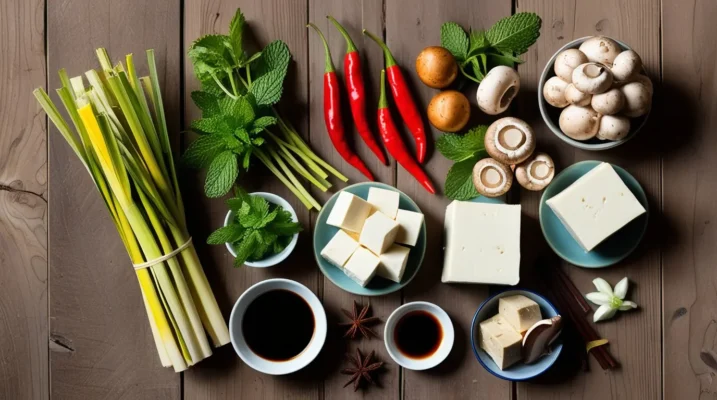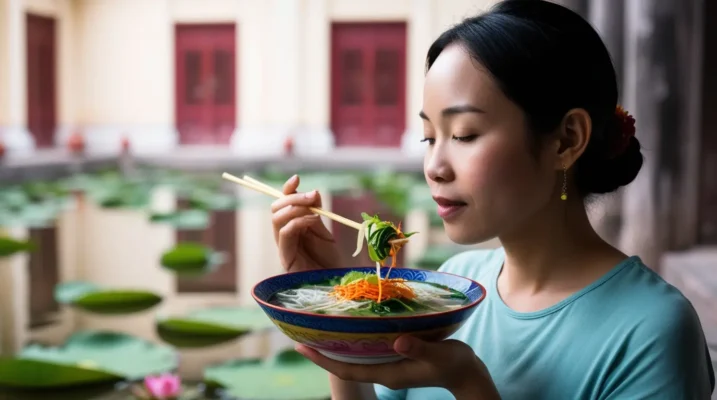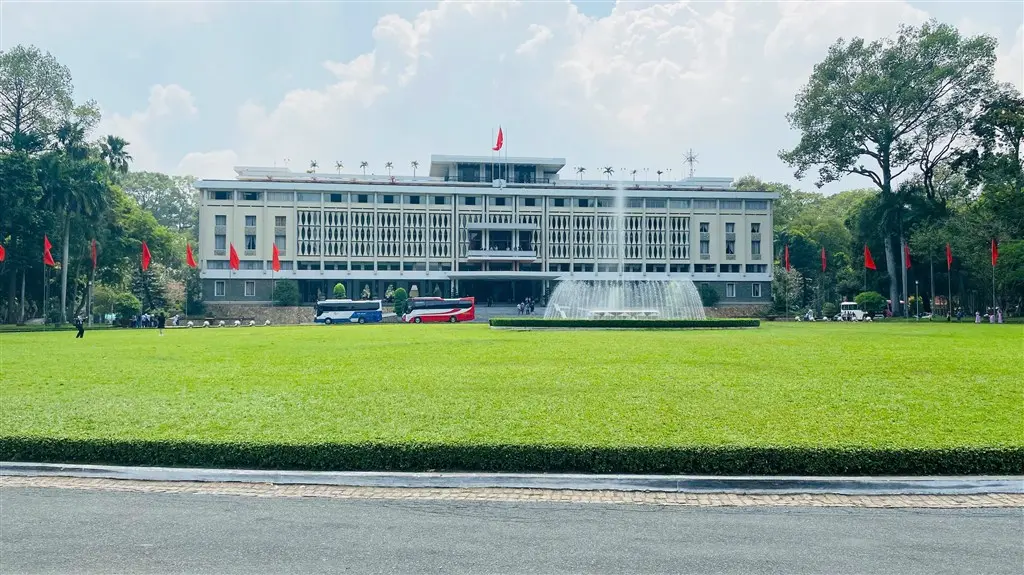Welcome to the vibrant world of Vietnamese vegetarian dishes. EssentialVietNamtravel.com guides you through Vietnam’s incredible plant-based options. “Do chay,” this celebrated food, is a key part of Vietnamese cuisine, reflecting respect for nature and a rich culinary history. People choose vegetarian food in Vietnamese culture for religious, health, or flavor preferences. This guide explores dishes, recipes, ingredients, cultural importance, and finding these meals in Vietnam. Discover the delicious vegetarian in vietnam, a highlight of Asian cuisine.
An Introduction to Chay Cuisine: Popular Types of Vietnamese Vegetarian Dishes Featuring Tofu and Fresh Flavors

Chay cuisine, or Vietnamese vegetarian food, offers a diverse and exciting culinary experience. It is far more than simple salads or plain vegetables; it is a sophisticated style that masterfully uses ingredients like versatile tofu, various flavorful mushrooms, and a wide array of fresh, locally sourced produce. This approach creates dishes that are both satisfyingly hearty and inherently healthy, aligning with plant-based diets.
The consistent emphasis in Chay cuisine is on the quality of fresh ingredients and achieving a harmonious balance of flavors, a signature of Vietnamese cooking. You will encounter many distinct vietnamese vegetarian dishes that showcase the ingenuity of Vietnamese cooks. These are not mere imitations of meat dishes but stand proudly with unique tastes and textures. From bustling city street food stalls to tranquil temple kitchens, chay food is an integral part of Vietnamese life, demonstrating the richness of Southeast Asian food traditions.
One of the most iconic Vietnamese vegetarian dishes you’ll find is Pho Chay. This is the vegetarian version of Vietnam’s globally renowned noodle soup. The broth base is typically a carefully simmered vegetable stock, rich with the essence of carrots, daikon radish, and mushrooms, and fragrant with spices like star anise, cinnamon, and ginger.
The main ingredient is soft flat rice noodles, while the protein source is often fried or simmered tofu. Fresh herbs such as Thai basil and cilantro, along with bean sprouts, are added at the end, and a squeeze of lime perfects this healthy vietnamese vegetarian noodle soup. It’s a comforting example of how vegetarian vietnamese dishes achieve depth.
Another widely loved option is Banh Mi Chay, the vegetarian take on the classic Vietnamese sandwich. The bread type is a crusty baguette, a delightful French colonial legacy. Inside, you’ll discover a vibrant mix: marinated tofu, perhaps a savory vegetarian pâté (often mushroom-based), and plentiful pickled vegetables like carrots and daikon. Fresh cucumber, cilantro, and optional chili complete this fulfilling sandwich. This is a popular vietnam vegetarian food, readily available from street vendors in cities like Hanoi and Ho Chi Minh City, making it easy to find food in vietnam for vegetarians.
For a lighter, refreshing choice, Goi Cuon Chay (vegetarian fresh spring rolls) are perfect. These are not fried; their delicate wrapper is rice paper, encasing vermicelli noodles, lettuce, shredded carrots, cucumber, and often tofu or mushrooms. The primary herb, mint, lends a distinct coolness. These rolls are usually served with a peanut hoisin sauce. Traditional vietnamese vegetarian spring rolls beautifully highlight the Vietnamese preference for fresh, raw ingredients and make for excellent light vietnamese vegetarian food.
Com Chay, translating to vegetarian rice, is a fundamental meal. It consists of steamed rice served with a variety of accompanying vegetarian side dishes. A common side is braised tofu, perhaps in a savory soy sauce or a rich tomato preparation (Dau Hu Sot Ca Chua, where the main ingredient is tofu and the sauce base is tomato). Other sides might include stir-fried vegetables or mushroom dishes.
The overall flavor profile is savory and deeply satisfying. Com Chay plates demonstrate the wonderful variety within vegetarianism in vietnam and are frequently found at dedicated “quan chay” (vegetarian eateries). This exploration of Chay cuisine showcases a commitment to plant-based diets rich in flavor and tradition.
Crafting Your Own: Easy Vietnamese Vegetarian Recipes for Delicious Home-Cooked Meals

Bringing the authentic flavors of Vietnamese vegetarian dishes into your home kitchen is a rewarding experience and often simpler than anticipated. Many core recipes are straightforward, emphasizing fresh ingredients and clear cooking methods. EssentialVietNamtravel.com believes that anyone can master these healthy Vietnamese meals.
Here are a few detailed easy vietnamese vegetarian recipes for beginners to guide you in creating your own Chay cuisine delights. These instructions aim to be clear, allowing anyone to achieve authentic results. Remember, recipes are transmissible and replicable, forming the heart of culinary heritage.
Making Pho Chay (Vegetarian Noodle Soup) Step-by-Step
Pho Chay offers comforting warmth and complex aromatics. This recipe serves four.
Ingredients for the Broth:
- 2 large onions, quartered
- 4-inch piece ginger, halved
- 2 carrots, chopped
- 1 daikon radish, chopped
- 10 dried shiitake mushrooms, rehydrated (reserve soaking water)
- 3 star anise pods
- 2 cinnamon sticks
- 4 cloves
- 1 tablespoon coriander seeds
- 12 cups water or vegetable stock (broth base)
- 2-3 tablespoons soy sauce
- 1 tablespoon sugar (optional)
- Salt to taste
Ingredients for the Bowls:
- 1 package (14-16 oz) dried flat rice noodles (banh pho – main ingredient)
- 1 block (14-16 oz) firm tofu, pressed and cubed (protein source)
- 2 tablespoons cooking oil
- 1 onion, thinly sliced
- 4 scallions, green parts sliced
- Fresh herbs: Thai basil, cilantro, mint
- Bean sprouts
- Lime wedges
- Sliced chilies (optional)
Instructions:
- Prepare Aromatics: Char the onions and ginger (under broiler, on gas flame, or dry pan) until fragrant and lightly blackened. This deepens flavor.
- Toast Spices: In a dry pan, toast star anise, cinnamon, cloves, and coriander seeds for 2-3 minutes until fragrant. Avoid burning.
- Make the Broth: In a large stockpot, combine charred aromatics, carrots, daikon, rehydrated shiitake (and their strained soaking water), toasted spices, and water/stock. Bring to a boil, then reduce heat and simmer for at least 1.5-2 hours.
- Strain and Season Broth: Strain the broth through a fine-mesh sieve. Season the clear broth with soy sauce, sugar (if using), and salt. Keep simmering.
- Prepare Tofu: While broth simmers, heat oil in a pan. Add cubed tofu and pan-fry until golden brown and slightly crispy.
- Cook Noodles: Cook rice noodles according to package directions. Drain and rinse with cold water. Divide among four large soup bowls.
- Assemble Bowls: Top noodles in each bowl with pan-fried tofu and thinly sliced raw onion.
- Serve: Ladle the hot, fragrant broth over noodles and tofu. Garnish generously with scallion greens, Thai basil, cilantro, mint, and bean sprouts. Serve immediately with lime wedges and chilies. This healthy vietnamese vegetarian noodle soup is a complete, flavorful meal.
Creating Banh Mi Chay (Vegetarian Vietnamese Sandwich) Step-by-Step
This sandwich masterfully combines fresh ingredients and contrasting textures. This recipe makes two sandwiches.
Ingredients:
- 2 small Vietnamese baguettes (bread type)
- 1 block (7 oz) firm tofu, pressed, sliced 1/4-inch thick
- 1 tablespoon soy sauce
- 1 teaspoon sesame oil
- 1/2 teaspoon sugar
- 1 clove garlic, minced (optional, as some Buddhist vegetarian practices exclude allium)
- 1 tablespoon cooking oil
- For Pickled Vegetables (Do Chua – Key Filling):
- 1 carrot, julienned
- 1/2 daikon radish (or 1 cup cucumber), julienned
- 1/4 cup rice vinegar
- 2 tablespoons sugar
- 1/2 teaspoon salt
- For Assembly:
- Vegetarian pâté (mushroom-based or other) or vegan mayonnaise (spread)
- Fresh cucumber, thinly sliced
- Fresh cilantro sprigs
- Sliced jalapeños or sriracha (optional)
Instructions:
- Pickle Vegetables: In a bowl, combine julienned carrot and daikon. In a small bowl, whisk rice vinegar, sugar, and salt until dissolved. Pour over vegetables. Toss. Let sit for at least 30 minutes.
- Marinate and Cook Tofu: Whisk soy sauce, sesame oil, sugar, and garlic (if using). Add tofu slices, coat, and marinate 15 minutes. Heat oil in a pan. Cook tofu 3-4 minutes per side until golden.
- Prepare Baguettes: Slice baguettes lengthwise (not fully through). Optionally, scoop out some soft bread. Lightly toast if desired.
- Assemble the Bánh Mi: Spread vegetarian pâté or mayonnaise inside baguette halves. Layer cooked tofu. Add drained pickled vegetables. Top with cucumber, cilantro, and jalapeños/sriracha if using.
- Serve: Close sandwich, press gently. Serve immediately. This vietnam vegetarian food is ideal for a quick, delicious meal.
Assembling Goi Cuon Chay (Vegetarian Fresh Spring Rolls) Step-by-Step
These rolls are wonderfully refreshing, light, and customizable. This recipe makes about 8-10 rolls.
Ingredients:
- 8-10 sheets round rice paper (bánh tráng – wrapper)
- 4 oz thin rice vermicelli noodles
- 1 block (7 oz) firm tofu, pressed, cut into thin strips
- 1 tablespoon soy sauce (for tofu)
- 1 teaspoon oil (for tofu)
- 1 cup shredded lettuce
- 1/2 cup julienned carrots
- 1/2 cup julienned cucumber
- 1/2 cup fresh mint leaves (primary herb)
- 1/2 cup fresh cilantro leaves (optional)
- For Peanut Hoisin Dipping Sauce:
- 1/4 cup hoisin sauce
- 2 tablespoons smooth peanut butter
- 1-2 tablespoons warm water
- 1 teaspoon lime juice
- 1/2 teaspoon chili garlic sauce (optional) (Goi Cuon Chay, Dipping Sauce, Peanut Hoisin Sauce)
Instructions:
- Cook Noodles: Cook rice vermicelli according to package. Drain; rinse with cold water.
- Prepare Tofu: Optionally, toss tofu strips with soy sauce. Heat oil; pan-fry tofu briefly until lightly golden. Cool.
- Prepare Dipping Sauce: Whisk hoisin sauce, peanut butter, warm water, lime juice, and chili garlic sauce until smooth. Adjust water for consistency.
- Set Up Rolling Station: Fill a wide, shallow dish with warm water. Arrange all fillings on a platter. Have a clean, damp towel or flat plate for rolling.
- Roll the Goi Cuon:
- Dip one rice paper sheet in warm water for 15-20 seconds until pliable.
- Lay wet rice paper flat. About one-third from the edge, place lettuce, noodles, tofu, carrots, cucumber, and herbs. Do not overfill.
- Fold bottom edge over filling. Fold in sides. Roll tightly from bottom up. If fresh spring roll, then typically not fried.
- Serve: Place finished rolls on a platter (prevent sticking). Serve immediately with peanut hoisin dipping sauce. These traditional vietnamese vegetarian spring rolls are best enjoyed fresh.
These easy vietnamese vegetarian recipes for beginners should provide a great start. As you grow confident, explore other Chay cuisine, like vegan vietnamese tofu lemongrass stir-fry. Enjoy your journey into Vietnamese cooking!
The Soul of the Cuisine: Essential Ingredients and Signature Flavors in Vietnamese Vegetarian Food

Vietnamese vegetarian food, or “Do chay viet nam,” derives its unique character from a core set of ingredients and a philosophy of flavor balance. Understanding these elements is key to appreciating and recreating these delightful plant-based Vietnamese food options. EssentialVietNamtravel.com highlights these building blocks of Chay cuisine, showcasing how simple components create complex and satisfying healthy Vietnamese meals. The ingredients are often locally sourced and fresh, reflecting Vietnam’s agricultural richness.
Key Ingredients – The Flavor Foundations
The Vietnamese vegetarian pantry is rich with versatile items.
- Tofu (Đau Hu): A cornerstone of many Vietnamese vegetarian dishes and a primary protein source. It appears as firm, soft, fried puffs (great for soaking sauces), or pungent fermented tofu (chao). Tofu Vietnamese recipes are incredibly varied, demonstrating sophisticated use of tofu and seitan. Tofu is a vital entity.
- Mushrooms (Nam): Various mushrooms (shiitake, oyster, wood ear) lend umami and meaty textures, crucial for plant-based diets. They enrich broths, stir-fries, and fillings.
- Rice and Rice Noodles (Com va Bun, Pho): Rice (cơm) is fundamental, often served as Com Chay (main component steamed rice, common side braised tofu). Rice noodles are key too: flat ones (bánh phở) for Pho Chay, thin vermicelli (bún) for rolls and salads. If Vietnamese dish, then likely uses rice or rice noodles. Rice is a salient entity.
- Fresh Herbs: An abundance of fresh herbs (mint, cilantro, Thai basil, perilla) is a defining trait. Added raw or as a side, they provide fresh, aromatic notes. This emphasis on fresh herbs is a unique characteristic.
- Vegetables: A wide array of vegetables (carrots, daikon, morning glory, bok choy, bean sprouts) forms the backbone of healthy meals.
- Lemongrass (Sa): This aromatic grass gives a distinct citrusy flavor to marinades, soups (like Canh Chua Chay – taste profile sour soup, key vegetable okra), and stir-fries such as vegan vietnamese tofu lemongrass stir-fry.
- Soy Sauce (Nuoc Tuong): The primary savory seasoning, replacing fish sauce.
- Nuoc Mam Chay (Vegetarian Fish Sauce): A clever vegetarian version of fish sauce, often made from pineapple or mushrooms, allowing enjoyment of classic dipping sauces.
Signature Flavors and Philosophy – The Art of Balance
Vietnamese cuisine, including Chay cuisine, seeks a balance of five flavors: sweet, sour, salty, bitter, and spicy. This balance is key in individual dishes and entire meals, ensuring a dynamic experience. Dishes aim for a balance of textures and flavors.
- Sweetness often comes from palm sugar or fruits.
- Sourness from lime juice, tamarind, or vinegar.
- Saltiness primarily from soy sauce.
- Bitterness from certain herbs or vegetables.
- Spiciness from fresh chilies or chili sauce.
Texture is also vital, with dishes offering contrasts like crispy with soft. The light and non-greasy preparation, common in many vietnamese vegetarian dishes, is appealing. Steaming, boiling, and quick stir-frying preserve natural flavors. This focus on freshness makes vegetarian Vietnamese options healthy. The Yin-yang symbol can represent this balance. Chopsticks are the usual utensils.
More Than Just a Meal: The Health Benefits and Cultural Significance of Plant-Based Vietnamese Food

Vietnamese vegetarian cuisine, “Do an chay viet nam,” is more than abstaining from meat. It’s deeply connected to cultural traditions, religious practices (especially Buddhism), and a philosophy of healthy living. This approach offers significant nutritional benefits and holds a special place in Vietnamese society. EssentialVietNamtravel.com explores these dimensions, showing how Chay food is a window into Vietnamese culture. Followers adhere to vegetarianism for ethical, religious, or health reasons, all respected within this tradition. These meals are plant-based, flavorful, aromatic, fresh, and nutritious.
Unpacking the Health Benefits of Chay Cuisine
A diet including plant-based Vietnamese food aligns with healthy eating principles.
- Rich in Nutrients: Vietnamese vegetarian dishes are packed with vitamins, minerals, and fiber from fresh vegetables, fruits, legumes (like tofu), and herbs. These healthy Vietnamese meals support well-being.
- Lower in Saturated Fat and Cholesterol: Excluding meat makes these meals lower in saturated fats and cholesterol, beneficial for heart health, contrasting with a carnivorous diet.
- High in Fiber: Abundant vegetables and legumes promote digestive health and can aid weight management.
- Antioxidant Power: Fresh herbs, colorful vegetables, and spices like ginger are rich in antioxidants, protecting against cell damage.
- Promotes Mindful Eating: Preparing and enjoying chay food often encourages mindful eating, fostering appreciation for food and its origins, key to a healthy lifestyle.
Cultural and Religious Significance – A Compassionate Tradition
Vegetarianism in Vietnam, particularly Chay cuisine, has strong roots in Mahayana Buddhism. The symbol of Buddha is common in vegetarian spots.
- Influence of Mahayana Buddhism: Many Vietnamese Buddhists practice vegetarianism, especially on the 1st and 15th lunar days, and during festivals like Vu Lan or Lunar New Year (Tet). This stems from compassion and non-harming (ahimsa). Temples often serve vegetarian meals. The influence of Mahayana Buddhism is a unique characteristic.
- Lunar Calendar Observances: Eating vegetarian on specific lunar days is widespread, reflecting respect for tradition and a desire for purification. The Green leaf symbolizes this fresh approach.
- Community and Offerings: Vegetarian meals are shared within families and communities. Offering vegetarian food to ancestors is common.
- Philosophical Aspects: Some choose vegetarianism for ethical or environmental reasons, aligning with plant-based diets. There’s a rich tradition of vegetarian cooking in Vietnam. The lotus flower, symbolizing purity, often adorns vegetarian settings. This elevates Vietnamese vegetarian dishes beyond sustenance to an expression of cultural values, whether in Hanoi, Ho Chi Minh City, or the Mekong Delta.
Finding Authentic Delights: Tips for Discovering the Best Vegan Vietnamese Options and Plant-Based Vietnamese Meals
Navigating Vietnam for exceptional vegetarian food is a rewarding adventure. Whether you’re vegan or exploring plant-based vietnamese meals, the country offers abundant choices. EssentialVietNamtravel.com provides tips to discover the best vegetarian vietnamese food, ensuring a smooth culinary journey. You can confidently find satisfying vegan vietnamese dishes and healthy Vietnamese meals. Remember, if vegetarian, then no animal flesh.
Look for “Quan Chay” or “Com Chay” Signs: The easiest way to find vegetarian food is to spot “Quan Chay” (vegetarian restaurant) or “Com Chay” (vegetarian rice) signs. These places exclusively serve vegetarian dishes. They are common in cities like Hanoi and Ho Chi Minh City, and often near temples. Many offer buffet-style (com banh dân chay) or à la carte menus. This is a good way to try various do chay vietnam.
Learn Key Vietnamese Phrases: Knowing basic phrases helps, especially in local spots:
- “An chay” (ahn chai) – I eat vegetarian.
- “Toi an chay” (toy an chai) – I am vegetarian.
- “Khong thit” (khong thit) – No meat.
- “Khong nuoc mam” (khong nuoc mam) – No fish sauce. Ask for “nuoc tương” (soy sauce) or “nuoc mam chay” (vegetarian fish sauce).
Specify Vegan Requirements: While many chay dishes are vegan, some might use eggs or (rarely) dairy. If strictly vegan, clarify:
- “Khong trung” (khong trung) – No eggs.
- “Khong sua” (khong sua) – No milk/dairy. Most chay places, especially Buddhist ones, understand. Vegan food vietnam is increasingly accessible.
Explore Markets and Street Food (with awareness): Local markets (cho) offer fresh produce and sometimes vegetarian snacks. Banh Mi Chay is a common street food. Be observant about cross-contamination if concerned. Many vendors are accommodating. Vietnamese street food has many delights.
Check Restaurant Menus in Tourist Areas: Many regular restaurants in tourist spots now offer vegetarian sections or adapt dishes. Don’t hesitate to ask for vegan vietnamese options.
Use Online Resources and Apps: Websites like HappyCow help locate vegetarian/vegan restaurants, useful for finding the best vietnamese vegetarian restaurants in hanoi or other cities.
Visit Temples on Observance Days: On the 1st and 15th lunar days, temples often serve vegetarian food, an authentic cultural experience. You might find regional monastic recipes.
Embrace Tofu Vietnamese Recipes: Don’t avoid tofu dishes. Vietnamese cooks excel at transforming tofu. From Dau Hu Sot Ca Chua (main ingredient tofu, sauce base tomato) to braised tofu, options are vast. Finding food in vietnam for vegetarians is usually positive.
Ready to Taste Vietnam’s Vegetarian Delights?
Your culinary adventure begins with a flight. Find the most affordable options to Ho Chi Minh City or Hanoi and experience these incredible dishes firsthand.
Exploring the Unique: Delving into Vietnamese Buddhist Cuisine and the Distinctive Characteristics of Vegetarian Dishes in Vietnam
Beyond everyday chay meals, Vietnamese Buddhist cuisine offers a specialized and often refined culinary experience. Found in monasteries or prepared for religious occasions, this tradition showcases remarkable artistry and adheres to specific principles. EssentialVietNamtravel.com invites you to explore these unique characteristics of vegetarian dishes in Vietnam, which often feature mock meat artistry and ancient herbal infusions, revealing a sophisticated food culture. Understanding this enriches the appreciation of plant-based diets in the region.
The Guiding Philosophy of Vietnamese Buddhist Cuisine
Rooted in Mahayana Buddhist principles of compassion (tu bi) and non-harming (ahimsa – bất sát sanh), this cuisine aims to nourish body and mind without harming sentient beings. This means strict vegetarianism, often veganism.
- Exclusion of Alliums (Ngu Vi Tan): A key feature is avoiding the “five pungent plants” (onions, garlic, leeks, chives, shallots), believed to stir passions. If Buddhist vegetarian, then often excludes allium. Chefs use ginger, galangal, lemongrass, and mushrooms for flavor instead.
- Purity and Simplicity: While some dishes are elaborate, the focus is on pure, natural flavors from wholesome ingredients. Food should be light and digestible.
- Mindful Preparation: Cooking is often a meditative practice. Food is prepared with calm focus, infusing it with positive energy. This is part of Vietnamese Buddhist cuisine.
The Art of Mock Meat (Mon Chay Gia Man) – Culinary Ingenuity
A fascinating aspect is “mon chay gia man” – vegetarian dishes mimicking meat/seafood, showcasing culinary skill.
- Ingredients: Made from tofu (especially yuba/tofu skin), seitan (wheat gluten), mushrooms (king oyster for texture), jackfruit, and banana blossom.
- Techniques: Sophisticated methods shape, color, and flavor these to resemble chicken, fish, etc. This might involve layering tofu skin or shredding mushrooms.
- Purpose: Makes vegetarian food approachable for those transitioning, allows recreation of traditional festive dishes, and showcases chefs’ skills in this unique characteristic of some Chay cuisine.
Regional Monastic Recipes and Royal Court Vegetarian Influence
While core principles are similar, regional variations exist. Monasteries might have special recipes using local ingredients, like more coconut milk in Mekong Delta dishes. Historically, royal court vegetarian influence from Hue led to refined vegetarian dishes, some of which, perhaps including ancient herbal infusions, persist in high-end chay cuisine. These regional monastic recipes add to the diversity.
The Signature of Lightness – Light and Non-Greasy Preparation
A consistent trait is light and non-greasy preparation. Steaming, boiling, simmering, and quick stir-frying are preferred. Even fried items are well-drained. This makes food feel clean and refreshing, highlighting natural flavors and contributing to the healthy profile of plant-based vietnamese meals. It’s a unique characteristic that enhances the balance of five flavors.
Exploring these facets, from simple Com Chay (with its savory flavor profile) to elaborate mock meats, reveals an ancient yet evolving tradition. It’s a testament to creating flavorful food from plants. Whether trying Dau Hu Sot Ca Chua or Nom Du Du Chay (green papaya salad with sweet and sour dressing), or a dessert like Che Chuoi (banana pudding where the main fruit is banana and consistency is sweet pudding), you engage with a rich heritage of healthy, mindful eating. This is the heart of do an chay vietnam.


